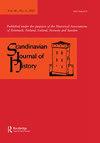囚禁:公元9世纪维京人在西欧掠夺、奴役和定居的交叉点
IF 0.8
3区 历史学
Q1 HISTORY
引用次数: 0
摘要
维京时代(公元750-1050年)是一个北方世界动荡不安的时代。从八世纪晚期开始,历史资料表明维京人组织参与了短期和长期的袭击和掠夺活动。除了寻找可携带的财富和商品,很明显,劫掠者还寻找俘虏,其中许多人被带走并关押在营地,在那里他们被勒索、剥削或卖为奴隶。虽然这些遗址作为防御据点和海盗袭击活动的中转站发挥了重要作用,但最近的研究表明,它们也是军事化的生产和交换中心,在某些情况下,它们成为嵌入区域和长途通信和贸易网络的节点市场。本研究将特别关注九世纪,研究俘虏和奴役与这些地区的出现和发展的交叉方式,以及这些活动在塑造更广泛的交流、外交和冲突与解决景观中的跨文化互动过程中的作用。本文章由计算机程序翻译,如有差异,请以英文原文为准。
Bound in captivity: intersections of viking raiding, slaving, and settlement in Western Europe during the ninth century CE
ABSTRACT The Viking Age (c. 750–1050 CE) was a time of extensive upheaval and disruption across the northern world. From the late eighth century, historical sources indicate that viking groups were engaging in both short-term and extended campaigns of raiding and plunder. In addition to seeking portable wealth and commodities, it is apparent that raiders also sought captives, many of whom were taken and held in encampments where they were ransomed, exploited, or sold into slavery. While these sites served an important function as defensive strongholds and staging posts for viking raiding activity, recent studies have demonstrated that they were also militarized centres of production and exchange that, in some cases, became nodal marketplaces that were embedded within both regional and long-distance networks of communication and trade. Focusing in particular on the ninth century, this study will examine the ways in which captive-taking and slaving intersected with the emergence and development of these locales, as well as the role of these activities in shaping wider processes of communication, diplomacy, and cross-cultural interaction within landscapes of conflict and settlement.
求助全文
通过发布文献求助,成功后即可免费获取论文全文。
去求助
来源期刊

SCANDINAVIAN JOURNAL OF HISTORY
HISTORY-
CiteScore
1.10
自引率
20.00%
发文量
33
期刊介绍:
Scandinavian Journal of History presents articles on Scandinavian history and review essays surveying themes in recent Scandinavian historical research. It concentrates on perspectives of national historical particularities and important long-term and short-term developments. The editorial policy gives particular priority to Scandinavian topics and to efforts of placing Scandinavian developments into a larger context. Studies explicitly comparing Scandinavian processes and phenomena to those in other parts of the world are therefore regarded as particularly important. In addition to publishing articles and review essays, the journal includes short book reviews. Review essay proposals and polemical communications are welcomed.
 求助内容:
求助内容: 应助结果提醒方式:
应助结果提醒方式:


